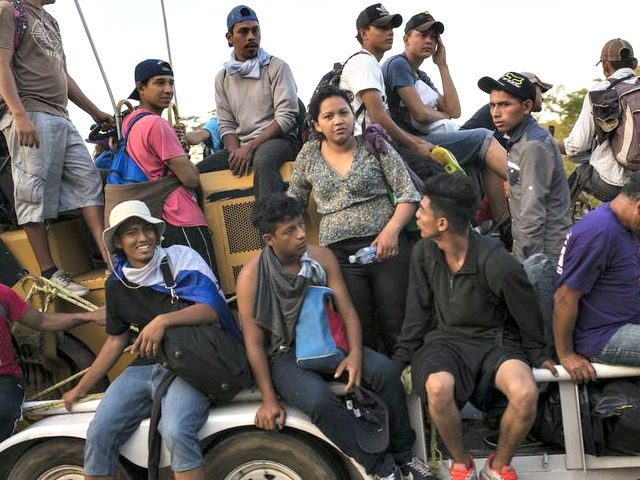President Donald Trump slammed leaders in Mexico and Central America on Thursday morning for allowing the wave of economic migrants to reach U.S. borders, just a few hours after United States Department of Homeland Security (DHS) Secretary Kirstjen Nielsen announced a “historic” deal with Central American countries.
Trump’s tweet said he might “close the Southern Border” to penalize Mexico, Honduras, Guatemala, and El Salvador which rely heavily on trade with the United States. But any border closure would generate a roar of objections from business leaders and GOP legislators in Congress.
Mexico is doing NOTHING to help stop the flow of illegal immigrants to our Country. They are all talk and no action. Likewise, Honduras, Guatemala and El Salvador have taken our money for years, and do Nothing. The Dems don’t care, such BAD laws. May close the Southern Border!
— Donald J. Trump (@realDonaldTrump) March 28, 2019
Trump’s statement that Central American leaders “do Nothing” came less than a day after Nielsen declared a “historic” agreement with leaders in Central America:
I'm pleased to announce the U.S. & our Northern Triangle allies have reached a HISTORIC agreement to confront the root causes of the crisis on our border. Working with Central American govts to increase security & prosperity in the region has been one of my greatest priorities. pic.twitter.com/QQMpZVI9yp
— Sec. Kirstjen Nielsen (@SecNielsen) March 27, 2019
Nielsen did not explain the “historic” deal in her tweet, which came out as border officials said the cross-border inflow hit 4,100 migrants on Tuesday and is on track to hit almost 1 million during 2019. The inflow is rising because Congress and the courts have cut many legal loopholes in border laws.
Trump said Mexican officials are “doing NOTHING to help stop the flow of illegal immigrants to our Country. They are all talk and no action.”
The charge comes after DHS officials revealed the existence of low-cost bus routes through Mexico for Central Americans seeking to reach the U.S. border. The Central Americans migrants take the bus routes through Mexico, then walk across the U.S. borderline, cross the fence or wall, ask for asylum, and are then released to take jobs and school seats in the United States.
However, the U.S. Congress is doing nothing to close the border loopholes and is actually aiding the migrant inflow. In February, for example, Congress agreed to spend more than $400 million to aid the migrants. It also established rules to protect the illegal immigrants in the United States who pay the cartels to smuggle their children through Mexico to U.S. border agencies.
The rising inflow of migrants will force down wages for blue-collar Americans, weaken schools used by blue-collar Americans, and drain government aid used by blue-collar Americans in an economy that already includes at least 11 million illegal migrants. The resident illegals — as well as 34 million legal immigrants — shift U.S. income towards employers, investors, and real-estate owners and also grab much attention and sympathy from elite Americans in Congress, the courts, and the media.
Nielsen also tweeted out a video of her speech to a Wednesday meeting of regional leaders:
.@DHSgov @SecNielsen’s closing statement at the V Northern Triangle security ministers meeting in #Honduras. https://t.co/DOsmYHk7Yh
— US Embassy Honduras (@usembassyhn) March 27, 2019
She said:
Our message to criminals is this ‘You will be caught and you will be prosecuted.’ While this agreement between our nations is the first of its kind, and it is not a silver bullet to ending our shared migration crisis, the United States stands with its friends in the Northern Triangle and have always helped spur economic prosperity throughout out the region. However, more must be done to combat this crisis and the United States must see measurable improvements in the short term.
Each year, roughly four million young Americans join the workforce after high school or university. The federal government then imports roughly 1.1 million legal immigrants, refreshes a resident population of roughly 1.5 million white-collar guest workers and roughly 500,000 blue-collar visa workers, and it also tolerates about eight million illegal workers.
In 2019, because of catch-and-release rules mandated by Congress and the courts, the federal government also will likely release at least 350,000 Central American laborers into the U.S. job market, even as at least 500,000 more migrants sneak past U.S. border defenses or overstay their visas.
Overall, in 2019, the U.S. government will allow at least two million new foreign workers into the United States to compete for the starter jobs sought by the latest wave of four million U.S. graduates. The new migrants also undermine the 24 million other Americans and the roughly three million legal immigrants who have joined the workforce since 2014.
This federal policy of using legal and illegal migration to boost economic growth for investors shifts enormous wealth from young employees towards older investors by flooding the market with cheap white-collar graduates and blue-collar foreign labor.
This cheap labor economic policy forces Americans to compete even for low wage jobs, it widens wealth gaps, reduces high tech investment, increases state and local tax burdens, hurts kids’ schools and college education, pushes Americans away from high-tech careers, and sidelines millions of marginalized Americans, including many who are now struggling with fentanyl addictions.

COMMENTS
Please let us know if you're having issues with commenting.